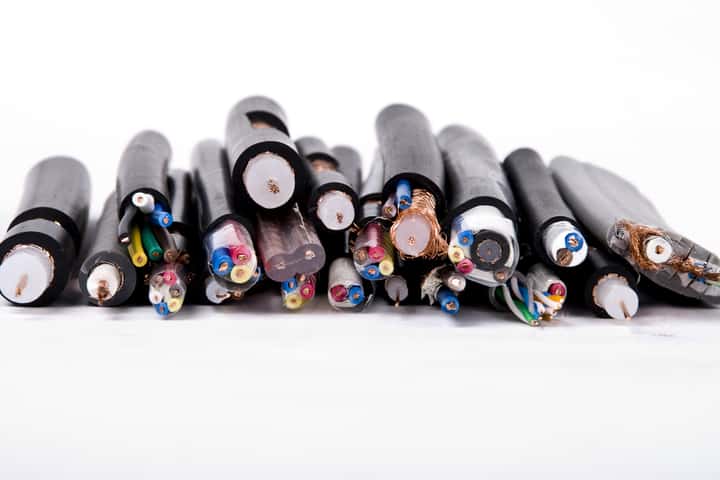While most people will spend a long time planning which lights they’re going to add to their landscape setup and carefully selecting the proper transformer, it’s essential not to overlook the choice of wire.
Your outdoor lighting cable will impact how far you can run the wire and how many lights you can add without any voltage drop.
You are watching: What Gauge Wire Do I Need For Landscape Lighting?
This could impact the performance of the lights, causing them to flicker or shine dimly.
The most common cable gauge used for outdoor lighting is 12/2. Although if you’re running cables over longer distances or adding more lights in series, you may want a thicker cable such as 10/2 or even 8/2. This will prevent voltage drop from affecting your lights.
There’s a lot to break down when it comes to wire gauges, so let’s look at:
- Which gauge you need for low voltage lighting
- The difference between 14/2 and 12/2 wire
- How far you can run 16/2 wire
- How the wire gauge impacts voltage drop
What Gauge Wire For Low Voltage Landscape Lighting?

There are two main considerations when choosing your wire for your outdoor lighting setup.
You need to choose which type of wire you want to use, and then select the right gauge.
Wire Type

You’ll struggle to find any outdoor lighting cables that aren’t copper – it’s the best balance between the cost and performance of any conductive material.
When it comes to wire type, you’re more looking out for how suitable the wire is to be used underground:
- Outdoor cable is safe to use outdoors, and will be resistant to moisture and UB damage, but it shouldn’t be buried.
- Underground burial cable is designed to be used underground but it needs a conduit – it’s not tough enough to directly withstand the pressure of the earth.
- Direct burial cable is fully protected for underground use and doesn’t need a conduit or sleeve.
Most cables you’ll find will be rated for direct burial if you’re searching for landscape lighting but it’s worth checking before you purchase.
Gauge Chart
The wire gauge is a measurement of how thick the wire is, and it’s important that you choose the right one for your lighting circuit.
Buying a cable that doesn’t support your landscape lighting design will mean you don’t get enough power for all of your lights. As a result, they may be inconsistently bright or flicker.
In North America, wire is measured in American Wire Gauge (AWG). The smaller the number on the AWG scale, the thicker the wire. For example, the thickest wire is 0000 (4/0), 0.46 inches (11.7mm) thick.
There are then 000, 00, and 0 options before you get to a more standard 1 through to 26 rating, with 26 being the thinnest widely-available cable at 0.0159 inches (0.4mm) thick.
For outdoor lighting, though, the most common choices run between 8 and 18. While you can get AWG wire at any number, usually they’re sold in steps of two – so 8, 10, 12, 14, 16, and 18.
Wires will also usually have a number after the slash, and that’s normally 2, so wires for outdoor lighting are 8/2, 10/2, 12/2, and so on. The “2” refers to the number of conductors within the wire.
Read more : How to Clean Teak Furniture Properly
Here’s why the thickness of the wire matters. Thicker wire:
- Is more expensive, because it uses more copper
- Is less flexible, which can make it a little harder to use in tight spaces
- Can handle more wattage
- Will have less voltage drop over longer distances
Wire gauge Thickness (inches) Thickness (mm) Maximum recommended wattage 18/2 0.0403 1.02 96 16/2 0.0508 1.29 132 14/2 0.0641 1.63 192 12/2 0.0808 2.05 240 10/2 0.102 2.59 360 8/2 0.129 3.26 480
Remember that you can run multiple connections from a transformer.
So, the maximum recommended wattage for a wire is for anything on that part of the circuit only.
If you have a large landscape lighting setup with 400W lighting, you could run two circuits on 12/2 wire.
It’s also worth highlighting that these are recommended maximums for the wire gauge based on a 12V power supply, which is commonly used for outdoor lighting.
Indoor circuits with a higher voltage can handle a lot more, but the transformer steps down the power, so they don’t work in the same way.
Also, bear in mind that you’re limited by your transformer too.
Just because you use 10/2 gauge wire, if your transformer has a maximum wattage rating of 200W, you will be limited to that.
In fact, it’s recommended you aim for 80% of your transformer’s max capacity to handle fluctuations.
Difference Between 14/2 vs 12/2 Landscape Wire

14/2 landscape wire is thinner than 12/2, which means it’s cheaper but can’t carry as much wattage, and it’s not as effective over longer distances.
12/2 is the most popular choice for landscape wiring because of its balance between cost and performance.
It’s effective for lighting systems up to 240 Watts compared to 192 Watts for 14/2 and you’ll get less voltage drop – more on that below.
How Far Can You Run 16/2 Wire?

How far you can run a wire depends on how many lights you want to connect to it and the voltage drop.
As a guide, for 16/2 wire, you can connect up to 132 Watts as long as the cable isn’t more than 100 feet. Any more than that, and you’re likely to have issues with the lights not working properly.
Does Bigger Wire Gauge Reduce Voltage Drop?

Read more : Outdoor Antenna Installation Tips
Everything electrical has resistance, including simple wire. So for every foot of wire, you’ll lose a little bit of power as the voltage slightly decreases.
It’s marginal, but when you’re dealing with landscape lighting over longer distances, then it can have an impact.
‘Bigger’ wire (the thicker wire with a lower AWG rating) reduces voltage drop – the resistance in the thicker wire is less. So less voltage is lost across the distance.
Thankfully, you can use a formula to calculate voltage drop before you install anything.
You don’t need to try one cable and remove it completely if the voltage drop is too much.
Firstly you need the wire constant information.
This varies depending on your wire material, but since almost all landscape wiring is made from copper, here’s the values for copper wiring:
Wire Gauge Constant 18/2 1380 16/2 2200 14/2 3500 12/2 7500 10/2 11920 8/2 18960
Now you just need to multiply the length of the wire you plan on using (in feet) by the total wattage of the lights.
Divide that number by the wire constant, and then multiply the result by 2. That will give you the voltage drop.
As long as the voltage drop is less than 1.5V, you shouldn’t notice any visible difference in the performance of your lighting setup.
Here’s an example:
- If you’re using 60W of lights but you’re running the cable 50 feet and you want to see whether the 16/2 cable will work.
- 60W multiplied by 50 feet = 3,000
- Divide this by the constant of 16/2 wire: 3000 / 2200 = 1.36
- Multiply this by 2 and you get 2.72 lost by the end of the wire – way too high!
But swap in 12/2 cable:
- 3000 / 7500 = 0.4.
- Multiply that by 2 and you get 0.8V lost, which is well within acceptable limits.
Stick with this formula, and you should have no trouble working out which gauge cable to use for your lighting system. Just keep that constant information handy.
Final Words
While cost and wattage rating will play a part, the biggest consideration when choosing a wire gauge will always be a voltage drop.
Especially when you’re running a long circuit of more than 50 feet.
The long-distance means that you might experience dimming or flickering in your lights, spoiling the overall effect.
Thankfully, with the formula above, it’s easy to work it out before you lay any cables – you won’t need to do a trial run and dig everything up.
If you’ve already created your landscape lighting setup, which wire gauge did you go for?
Source: https://gardencourte.com
Categories: Outdoor


